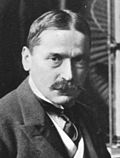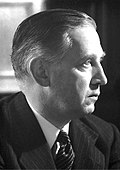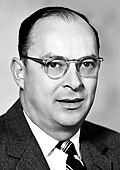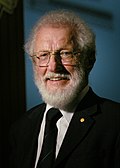Top Qs
Timeline
Chat
Perspective
IEEE Medal of Honor
Award conferred by the Institute of Electrical and Electronics Engineers From Wikipedia, the free encyclopedia
Remove ads
The IEEE Medal of Honor is the highest recognition of the American Institute of Electrical and Electronics Engineers (IEEE). It has been awarded since 1917, and is presented to an individual or team of up to three who have made exceptional contributions or had extraordinary careers in technology, engineering, and science in the IEEE fields of interest. The award consists of a gold medal, a bronze replica (of the medal), a certificate,[1] and a US$2 million honorarium.[a][3]
Quick facts Awarded for, Presented by ...
| IEEE Medal of Honor | |
|---|---|
 | |
| Awarded for | Exceptional contribution or an extraordinary career in the IEEE fields of interest |
| Presented by | Institute of Electrical and Electronics Engineers |
| First award | 1917 |
| Website | corporate-awards |
Close
The medal was created by the Institute of Radio Engineers (IRE) as the "IRE Medal of Honor". It became the IEEE Medal of Honor when the IRE merged with the American Institute of Electrical Engineers (AIEE) to form the IEEE in 1963. It was decided that IRE's Medal of Honor would be presented as IEEE's highest award. Edward Field Sanford Jr., an American sculptor, designed the medal in 1917.[2]
The first recipient was Edwin Howard Armstrong, in 1917.[2] As of 2024, 104 people have been awarded the medal, with the latest recipient being Robert E. Kahn.[4] Only one woman, Mildred Dresselhaus, has been awarded the medal, in 2015.[5][6]
Remove ads
Recipients
More information Year, Name ...
| Year | Name | Image | Citation[7] | Ref. |
|---|---|---|---|---|
| 1917 | Edwin Howard Armstrong |  |
"In recognition of his work and publications dealing with the action of the oscillating and non-oscillating audio" | [8] |
| 1918 | No award | |||
| 1919 | Ernst Alexanderson |  |
"In recognition of his pioneer accomplishments in the field of long distance radio communication, including his development of the radio frequency alternator which bears his name, a magnetic amplifier permitting effective modulation of the output of such an alternator, and a cascade radio frequency vacuum tube amplifier yielding exceptional total amplification" | [9] |
| 1920 | Guglielmo Marconi |  |
"In recognition of his pioneer work in radio telegraphy" | [10] |
| 1921 | Reginald Aubrey Fessenden |  |
(No citation) | [11] |
| 1922 | Lee de Forest |  |
"For his major contributions to the communications arts and sciences, as particularly exemplified by his invention of that outstandingly significant device: the three electrode vacuum tube, and his work in the fields of radio telephonic transmission and reception" | [12] |
| 1923 | John Stone Stone |  |
"For his valuable pioneer contributions to the radio art" | [13] |
| 1924 | Michael I. Pupin |  |
"In recognition of his fundamental contributions in the field of electrical tuning and the rectification of alternating currents used for signaling purposes" | [14] |
| 1925 | No award | |||
| 1926 | Greenleaf Whittier Pickard |  |
"For his contributions to crystal detectors, coil antennas, wave propagation and atmospheric disturbances" | [15] |
| 1927 | Louis W. Austin |  |
"For his pioneer work in the quantitative measurement and correlation of factors involved in radio wave transmission" | [16] |
| 1928 | Jonathan Zenneck |  |
"For his contribution to original researches in radio circuit performance and to the scientific and educational contributions to the literature of the pioneer radio art" | [17] |
| 1929 | George W. Pierce |  |
"For his major contributions in the theory and operation of crystal detectors, piezoelectric crystals and magnetostriction frequency controls and magnetostriction devices for the production of sound; and for his instructional leadership as a teacher and as a writer of important texts in the electric wave field" | [18] |
| 1930 | Peder Oluf Pedersen | — | (No citation) | [19] |
| 1931 | Gustave A. Ferrie |  |
"For his pioneer work in the up building of radio communication in France and in the world, his long continued leadership in the communication field, and his outstanding contributions to the organization of international cooperation in radio" | [20] |
| 1932 | Arthur Edwin Kennelly |  |
"For his studies of radio propagation phenomena and his contributions to the theory and measurement methods in the alternating current circuit field which now have extensive radio application" | [21] |
| 1933 | John Ambrose Fleming |  |
"For the conspicuous part he played in introducing physical and engineering principles into the radio art" | [22] |
| 1934 | Stanford C. Hooper |  |
"For the orderly planning and systematic organization of radio communication in the Government Service with which he is associated (United States Navy), and the concomitant and resulting advances in the development of radio equipment and procedure" | [23] |
| 1935 | Balthasar van der Pol |  |
"For his fundamental studies and contributions in the field of circuit theory and electromagnetic wave propagation phenomena" | [24] |
| 1936 | George Ashley Campbell | — | "For his contributions to the theory of electrical network" | [25] |
| 1937 | Melville Eastham | — | "For his pioneer work in the field of radio measurements, his constructive influence on laboratory practice in communication engineering, and his unfailing support of the aims and ideals of the Institute" | [26] |
| 1938 | John H. Dellinger |  |
"For his contributions to the development of radio measurements and standards, his researches and discoveries of the relation between radio wave propagation and other natural phenomena, and his leadership in international conferences contributing to the world wide cooperation in telecommunications" | [27] |
| 1939 | Albert G. Lee | — | "For his accomplishments in promoting international radio services and in fostering advances in the art and science of radio communication" | [28] |
| 1940 | Lloyd Espenschied | — | "For his accomplishments as an engineer, as an inventor, as a pioneer in the development of radio telephony, and for his effective contributions to the progress of international radio coordination" | [29] |
| 1941 | Alfred Norton Goldsmith |  |
"For his contributions to radio research, engineering, and commercial development, his leadership in standardization, and his unceasing devotion to the establishment and upbuilding of the Institute and its Proceedings" | [30] |
| 1942 | Albert H. Taylor |  |
"For his contributions to radio communication as an engineer and organizer, including pioneering work in the practical application of piezoelectric control to radio transmitters, early recognition and investigation of skip distances and other high-frequency wave-propagation problems, and many years of service to the government of the United States as an engineering executive of outstanding ability in directing the Radio Division of the Naval Research Laboratory" | [31] |
| 1943 | William Wilson | — | "For his achievements in the development of modern electronics, including its application to radio-telephony, and for his contributions to the welfare and work of the Institute" | [32] |
| 1944 | Haraden Pratt | — | "In recognition of his engineering contributions to the development of radio, of his work in the extension of communication facilities to distant lands, and of his constructive leadership in Institute affairs" | [33] |
| 1945 | Harold H. Beverage |  |
"In recognition of his achievements in radio research and invention, of his practical applications of engineering developments that greatly extended and increased the efficiency of domestic and world-wide radio communications and of his devotion to the affairs of the Institute of Radio Engineers" | [34] |
| 1946 | Ralph Hartley |  |
"For his early work on oscillating circuits employing triode tubes and likewise for his early recognition and clear exposition of the fundamental relationship between the total amount of information which may be transmitted over a transmission system of limited band-width and the time required" | [35] |
| 1947 | No award | |||
| 1948 | Lawrence C. F. Horle |  |
"For his contributions to the radio industry in standardization work, both in peace and war, particularly in the field of electron tubes, and for his guidance of a multiplicity of technical committees into effective action" | [36] |
| 1949 | Ralph Bown | — | "For his extensive contributions to the field of radio and for his leadership in Institute affairs" | [37] |
| 1950 | Frederick Terman | — | "For his many contributions to the radio and electronic industry as teacher, author, scientist and administrator" | [38] |
| 1951 | Vladimir Zworykin |  |
"For his outstanding contributions to the concept and development of electronic apparatus basic to modern television, and his scientific achievements that led to fundamental advances in the application of electronics to communications, to industry and to national security" | [39] |
| 1952 | Walter R. G. Baker |  |
"In recognition of his outstanding direction of scientific and engineering projects; for his statesmanship in reconciling conflicting viewpoints and obtaining cooperative effort; and for his service to the Institute" | [40] |
| 1953 | John Milton Miller |  |
"In recognition of his pioneering contributions to the fundamentals of electron tube theory and measurements, to crystal controlled oscillators and to receiver development" | [41] |
| 1954 | William L. Everitt |  |
"For his distinguished career as author, educator and scientist; for his contributions in establishing electronics and communications as a major branch of electrical engineering; for his unselfish service to his country; for his leadership in the affairs of The Institute of Radio Engineers" | [42] |
| 1955 | Harald T. Friis | — | "For his outstanding technical contributions in the expansion of the useful spectrum of radio frequencies, and for the inspiration and leadership he has given to young engineers" | [43] |
| 1956 | John V. L. Hogan |  |
"For his contributions to the electronic field as a founder and builder of The Institute of Radio Engineers, for the long sequence of his inventions, and for his continuing activity in the development of devices and systems useful in the communications art" | [44] |
| 1957 | Julius Adams Stratton | — | "For his inspiring leadership and outstanding contributions to the development of radio engineering, as teacher, physicist, engineer, author and administrator" | [45] |
| 1958 | Albert Hull |  |
"For outstanding scientific achievement and pioneering inventions and development in the field of electron tubes" | [46] |
| 1959 | Emory Leon Chaffee |  |
"For his outstanding research contributions and his dedication to training for leadership in radio engineering" | [47] |
| 1960 | Harry Nyquist | — | "For fundamental contributions to a quantitative understanding of thermal noise, data transmission and negative feedback" | [48] |
| 1961 | Ernst A. Guillemin | — | "For outstanding scientific and engineering achievements" | [49] |
| 1962 | Edward Victor Appleton |  |
"For his distinguished pioneer work in investigating the ionosphere by means of radio waves" | [50] |
| 1963 | John Hays Hammond Jr. |  |
"For pioneering contributions to circuit theory and practice, to the radio control of missiles and to basic communication methods" | [51] |
| George C. Southworth | — | "For pioneering contributions to microwave radio physics, to radio astronomy, and to waveguide transmission" | [52] | |
| 1964 | Harold A. Wheeler | — | "For his analyses of the fundamental limitations on the resolution in television systems and on wideband amplifiers, and for his basic contributions to the theory and development of antennas, microwave elements, circuits, and receivers" | [53] |
| 1965 | No award | |||
| 1966 | Claude Elwood Shannon |  |
"For his development of a mathematical theory of communication which unified and significantly advanced the state of the art" | [54] |
| 1967 | Charles H. Townes |  |
"For his significant contributions in the field of quantum electronics which have led to the maser and the laser" | [55] |
| 1968 | Gordon K. Teal | — | "For his contributions to single crystal germanium and silicon technology and the single crystal grown junction transistor" | [56] |
| 1969 | Edward Ginzton | — | "For his outstanding contributions in advancing the technology of high power klystrons and their application, especially to linear particle accelerators" | [57] |
| 1970 | Dennis Gabor |  |
"For his ingenious and exciting discovery and verification of the principles of holography" | [58] |
| 1971 | John Bardeen |  |
"For his profound contributions to the understanding of the conductivity of solids, to the invention of the transistor, and to the microscopic theory of superconductivity" | [59] |
| 1972 | Jay W. Forrester | — | "For exceptional advances in the digital computer through his invention and application of the magnetic-core random-access memory, employing coincident current addressing" | [60] |
| 1973 | Rudolf Kompfner | — | "For a major contribution to world-wide communication through the conception of the traveling-wave tube embodying a new principle of amplification" | [61] |
| 1974 | Rudolf Kálmán |  |
"For pioneering modern methods in system theory, including concepts of controllability, observability, filtering, and algebraic structures" | [62] |
| 1975 | John Robinson Pierce |  |
"For his pioneering concrete proposals and the realization of satellite communication experiments, and for contributions in theory and design of traveling wave tubes and in electron beam optics essential to this success" | [63] |
| 1976 | No award | |||
| 1977 | H. Earle Vaughan | — | "For his vision, technical contributions and leadership in the development of the first high-capacity pulse-code modulation time-division telephone switching system" | [64] |
| 1978 | Robert Noyce |  |
"For his contributions to the silicon integrated circuit, a cornerstone of modern electronics" | [65] |
| 1979 | Richard Bellman | — | "For contributions to decision processes and control system theory, particularly the creation and application of dynamic programming" | [66] |
| 1980 | William Shockley |  |
"For the invention of the junction transistor, the analog and the junction field-effect transistor, and the theory underlying their operation" | [67] |
| 1981 | Sidney Darlington | — | "For fundamental contributions to filtering and signal processing leading to chirp radar" | [68] |
| 1982 | John Tukey | — | "For his contributions to the spectral analysis of random processes and the fast Fourier transform algorithm" | [69] |
| 1983 | Nicolaas Bloembergen |  |
"For pioneering contributions to Quantum Electronics including the invention of the three-level maser" | [70] |
| 1984 | Norman F. Ramsey |  |
"For fundamental contributions to very high accuracy time and frequency standards exemplified by the cesium atomic clock and hydrogen maser oscillator" | [71] |
| 1985 | John Roy Whinnery |  |
"For seminal contributions to the understanding and application of electromagnetic fields and waves to microwave, laser, and optical devices" | [72] |
| 1986 | Jack Kilby | — | "For fundamental contributions to semiconductor integrated circuit technology" | [73] |
| 1987 | Paul Lauterbur | — | "For the discovery of nuclear magnetic resonance imaging" | [74] |
| 1988 | Calvin Quate | — | "For the invention and development of the scanning acoustic microscope" | [75] |
| 1989 | C. Kumar Patel |  |
"For fundamental contributions to quantum electronics, including the carbon dioxide laser and the spin-flip Raman laser" | [76] |
| 1990 | Robert G. Gallager |  |
"For fundamental contributions to communications coding techniques" | [77] |
| 1991 | Leo Esaki |  |
"For contributions to and leadership in tunneling, semiconductor superlattices, and quantum wells" | [78] |
| 1992 | Amos E. Joel Jr. | — | "For fundamental contributions to and leadership in telecommunications switching systems" | [79] |
| 1993 | Karl Johan Åström | — | "For fundamental contributions to theory and applications of adaptive control technology" | [80] |
| 1994 | Alfred Y. Cho | — | "For seminal contributions to the development of molecular beam epitaxy" | [81] |
| 1995 | Lotfi A. Zadeh | "For pioneering development of fuzzy logic and its many diverse applications" | [82] | |
| 1996 | Robert Metcalfe |  |
"For exemplary and sustained leadership in the development, standardization, and commercialization of Ethernet" | [83] |
| 1997 | George H. Heilmeier |  |
"For discovery and initial development of electro-optic effects in liquid crystals" | [84] |
| 1998 | Donald Pederson | — | "For creation of the SPICE Program, universally used for the computer aided design of circuits" | [85] |
| 1999 | Charles Concordia | — | "For outstanding contributions in the area of Power System Dynamics which resulted in substantial improvements in planning, operation and security of extended power systems" " | [86] |
| 2000 | Andrew Grove |  |
"For pioneering research in characterizing and modeling metal oxide semiconductor devices and technology, and leadership in the development of the modern semiconductor industry" | [87] |
| 2001 | Herwig Kogelnik |  |
"For fundamental contributions to the science and technology of lasers and optoelectronics, and for leadership in research and development of photonics and lightwave communication systems" | [88] |
| 2002 | Herbert Kroemer |  |
"For contributions to high-frequency transistors and hot electron devices, especially heterostructure devices from heterostructure bipolar transistors to lasers, and their molecular beam epitaxy technology" | [89] |
| 2003 | Nick Holonyak |  |
"For a career of pioneering contributions to semiconductors, including the growth of semiconductor alloys and heterojunctions, and to visible light-emitting diodes and injection lasers" | [90] |
| 2004 | Tadahiro Sekimoto | — | "For contributions to digital satellite communications, promotion of information technology R&D, and technical and corporate leadership in computers and communications" | [91] |
| 2005 | James Flanagan | — | "For sustained leadership and outstanding contributions in speech technology" | [92] |
| 2006 | James D. Meindl | — | "For pioneering contributions to microelectronics, including low power, biomedical, physical limits and onchip interconnect networks" | [93] |
| 2007 | Thomas Kailath | — | "For exceptional development of powerful algorithms in the fields of communications, computing, control and signal processing" | [94][95] |
| 2008 | Gordon Moore |  |
"For pioneering technical roles in integrated-circuit processing, and leadership in the development of MOS memory, the microprocessor computer and the semiconductor industry" | [96] |
| 2009 | Robert Dennard |  |
"For invention of the single transistor Dynamic Random Access Memory and for developing scaling principles for integrated circuits" | [97] |
| 2010 | Andrew Viterbi |  |
"For seminal contributions to communications technology and theory" | [98] |
| 2011 | Morris Chang |  |
"For outstanding leadership in the semiconductor industry" | [99] |
| 2012 | John L. Hennessy |  |
"For pioneering the RISC processor architecture and for leadership in computer engineering and higher education" | [100] |
| 2013 | Irwin M. Jacobs |  |
"For leadership and fundamental contributions to digital communications and wireless technology" | [101][102] |
| 2014 | B. Jayant Baliga |  |
"For the invention, implementation, and commercialization of power semiconductor devices with widespread benefits to society" | [103] |
| 2015 | Mildred Dresselhaus |  |
"For leadership and contributions across many fields of science and engineering[104]" | [105] |
| 2016 | Dave Forney | — | "For pioneering contributions to the theory of error-correcting codes and the development of reliable high-speed data communications" | [106][107] |
| 2017 | Kees Schouhamer Immink |  |
"For pioneering contributions to video, audio, and data recording technology, including compact disc, DVD, and Blu-ray" | [108][109] |
| 2018 | Bradford W. Parkinson |  |
"For fundamental contributions to and leadership in developing the design and driving the early applications of the Global Positioning System" | [110] |
| 2019 | Kurt E. Peterson |  |
"For contributions to and leadership in the development and commercialization of innovative technologies in the field of MEMS (micro-electromechanical systems)" | [111] |
| 2020 | Chenming Hu |  |
"For a distinguished career of developing and putting into practice semiconductor models, particularly 3-D device structures, that have helped keep Moore’s Law going over many decades" | [112] |
| 2021 | Yaakov Ziv |  |
"For fundamental contributions to information theory and data compression technology, and for distinguished research leadership" | [113] |
| 2022 | Asad M. Madni | — | "For pioneering contributions to the development and commercialization of innovative sensing and systems technologies, and for distinguished research leadership"[114] | [115] |
| 2023 | Vinton G. Cerf |  |
"For co-creating the Internet architecture and providing sustained leadership in its phenomenal growth in becoming society’s critical infrastructure" | [116] |
| 2024 | Robert E. Kahn |  |
"For pioneering technical and leadership contributions in packet communication technologies and foundations of the Internet" | [117] |
| 2025 | Henry Samueli |  |
"For pioneering research and commercialization of broadband communication and networking technologies, and promotion of STEM education" | [118] |
Close
Remove ads
See also
Notes
References
External links
Wikiwand - on
Seamless Wikipedia browsing. On steroids.
Remove ads
Remove ads
